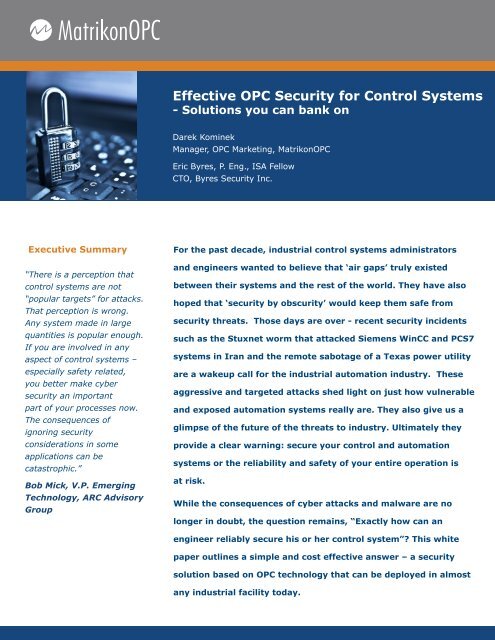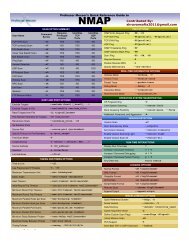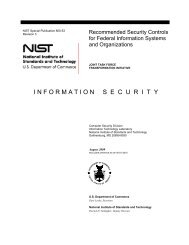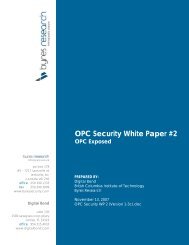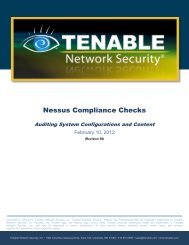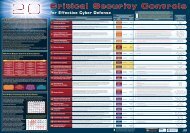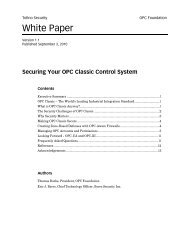Effective OPC Security for Control Systems - SCADAhacker
Effective OPC Security for Control Systems - SCADAhacker
Effective OPC Security for Control Systems - SCADAhacker
Create successful ePaper yourself
Turn your PDF publications into a flip-book with our unique Google optimized e-Paper software.
<strong>Systems</strong> are ChangingExample:Recent significantindustrial security incidents #1The Stuxnet worm, malwaredesigned specifically to attackSiemens WinCC, PCS7 and S7PLC projects, enters a controlsystem through infected USB keys(so Internet connectivity was anot a requirement <strong>for</strong> infection).However once inside it spreads toother computers using protocols<strong>for</strong> file sharing, printer sharing andSQL database access.Since there were no patches <strong>for</strong>these “attacks” when theworm was first discovered, thebest defense was to not letthose protocols reach criticalservers unless absolutely needed.Un<strong>for</strong>tunately, as noted earlier, oldfashioned <strong>OPC</strong> solutions would dojust the opposite – every protocolpossible was free to be sent to the<strong>OPC</strong> server, whether it was needed<strong>for</strong> control or not.In<strong>for</strong>mation networks have become the heart of the supervisorycontrol and data acquisition (SCADA) systems companies use to providecentralized management and monitoring capabilities. Traditionallycompanies constructed distributed control systems (DCS) and SCADAsystems that were separated from other corporate systems. Suchsystems were effectively “walled off” by proprietary equipment orprotocols.Business drivers have led to the convergence of companynetworks and industrial technologies. For example, the demand <strong>for</strong>remote access <strong>for</strong> either data access or support has rendered manycontrol systems accessible through non-SCADA networks. Similarly,many companies are reducing network deployment and managementcosts through shared hardware, backbones and network supportresources. Most important of all, the increased use of commercialoff-the-shelfcomputer components and office-network technologies hastrans<strong>for</strong>med the way business is conducted in almost every majorindustry. These standardization strategies are enabling companies tooperate cost effectively, communicate more efficiently and implementmore agile business practices through instant access to data throughoutthe organization, including the plant floor.While companies reap the benefits of these initiatives, many are alsodiscovering the inherent dangers that result from making controlnetworks more accessible to a wider range of users. Linking corporatesystems together to provide access to customers, suppliers, and otherthird parties significantly increases the vulnerability of sensitive andproprietary in<strong>for</strong>mation contained in these systems. It also exposes thesystems to external events such as worms, viruses and hackers. Thisincreases the demands on system administrators to balance the need <strong>for</strong>accessibility with the need to safeguard the integrity and usability of theirmission critical control systems.Reducing the Attack SurfaceOne of the most effective ways to manage the conflict between thedemands of efficient access and the demands of effective security is tominimize the variety of interfaces and protocols operating between thecontrol system and the external networks. Having one approvedconnection solution that serves multiple corporate requirements not onlyreduces deployment and administration costs, but also reduces theopportunities open to the attacker or worm. This is known as reducingthe “attack surface” of a system.Thus the first task <strong>for</strong> an administrator is to select an appropriatecommunications technology that can be used by the widest variety ofcontrol AND business systems. While there are a number of possiblecandidates, including Modbus TCP or Hyper Text Transfer Protocol (HTTP),<strong>OPC</strong> is without question one of the easiest and most widespreadstandards to address the demands of universal data access in theindustrial automation world.2
Example:Recent significantindustrial security incidents #2In a less famous incident, a majorenergy complex was infected by avirus in 2009, when a contractorremotely connected to a vibrationmonitoring system to providemaintenance support. The viruswas able to propagate from themonitoring system computersto various DCS servers, causingrepeated crashes of key serversand loss of production.At the time, the site usedtraditional IT firewalls to isolatethe various control systems.Un<strong>for</strong>tunately <strong>OPC</strong> Classic’s use ofdynamic ports resulted in firewallsrules being deployed that wereineffective in stopping the virus.<strong>OPC</strong>-aware firewalls like the Tofino<strong>OPC</strong> En<strong>for</strong>cer allow much tighterrules and would have prevented theworm from spreading.Once known as OLE <strong>for</strong> Process <strong>Control</strong> and now officially referred toas <strong>OPC</strong> Classic , it is the world’s most widely used industrial integrationstandard. It is employed by a broad range of industrial and businessapplications ranging from interfacing human machine interface (HMI)workstations, safety instrumented systems (SIS) and DCSs on the plantfloor, to enterprise databases, enterprise resource planning (ERP)systems and other business-oriented software in the corporate world.But what about the security demands - can <strong>OPC</strong> address these? As thispaper will illustrate, the answer is a definite YES. By layering defensesthat are <strong>OPC</strong>- aware, high security solutions can be created that meetboth the security and access expectations of a company, all withoutadministrative overload on the network or controls team. The result is astandards-based solution that has been proven across numerous differentcontrol systems.Layering DefensesIf reducing the attack surface is the first key to good security, thesecond is the layering of security defenses. Often referred to as ‘defensein depth’, the concept is to manage risk with diverse defensive strategies.Layering defenses gives several benefits. The most obvious is that if onelayer of defense is compromised, another layer of defense, using adifferent security method, presents an additional obstacle which caninhibit further penetration.A more subtle, but equally powerful benefit is that attacks come indifferent flavors and each defensive layer can be optimized to deal witha specific range of threats. For example, defending against a standardcomputer worm needs different techniques compared to defendingagainst a disgruntled employee. Thus a key to enhancing each defensein depth layer is ensuring that each layer of security considers thecontext of the in<strong>for</strong>mation or system it is protecting.Defense in Depth: Bank Example<strong>Security</strong> in a bank presents a good analogy <strong>for</strong> the defense in depthapproach to security <strong>for</strong> control systems. What is it that makes a typicalbank more secure than a home or convenience store? The bank employsmultiple security measures to maximize the safety and security of itsemployees, customers and their valuables. Not only are there morelayers, each layer is designed to address a specific type of threat at thepoint where it is employed. For example, just to name a few defenses,a typical bank has steel doors, bulletproof windows, security guards,security box keys, safes and security-trained tellers. Bank doors areeffective, but simple security devices. They are either locked or unlocked.They either grant or deny access to customers on an all-or-nothing basis– regardless of what a visitor looks like or how the visitor behaves.One layer up is the security guards – they per<strong>for</strong>m access control to‘clean’ the general flow of people into the bank. They ensure that accessto the bank is <strong>for</strong> people who have a legitimate need to be there and will3
‘behave’ within expected norms. They regard each visitor based onspecific criteria, such as, not wearing a mask, suspicious behavior,acting erratically etc.Backround:The term “<strong>OPC</strong> Classic” refersto all <strong>OPC</strong> standards prior to thenew <strong>OPC</strong>-Unified Architecture(<strong>OPC</strong>-UA) standard. This includesthe most popular specificationssuch as <strong>OPC</strong> Data Access (<strong>OPC</strong>DA), <strong>OPC</strong> Alarms and Events(<strong>OPC</strong> A&E) and <strong>OPC</strong> HistoricalData Access (<strong>OPC</strong> HDA).Visit the <strong>OPC</strong> Foundationwebsite <strong>for</strong> more in<strong>for</strong>mation.At yet another level, the tellers, security box keys, passwords, etc.keep these pre-screened customers from accessing other accountsor in<strong>for</strong>mation. Rather than worrying if a visitor should or should notbe in the bank, the tellers and passwords present a different layer ofsecurity: account security. These measures ‘filter’ what accountaccess individual customers are allowed, based on who they are.Note that the security layers are context specific, which is whybanks don’t simply have additional security guards at every level.The security solution must fit the context of the threat expected atthat level.Industrial <strong>Control</strong> System <strong>Security</strong>So what does this have to do with security on the plant floor?Well, <strong>for</strong> industrial communications the roles of the ’bank guard’and the ‘teller’ are broadly analogous to ‘Network <strong>Security</strong>’ and‘Application-Focused <strong>Security</strong>’.For example, the firewall acts like the guard, so that specifiedprotocols are either permitted or denied access into the controlnetwork. And just like a more experienced bank guard, a moresophisticated SCADA-aware firewall observes the traffic beyond theobvious protocol types and makes additional filtering decisions basedon the behavior and context of the systems using these protocols onthe network.Similarly, an <strong>OPC</strong> server with a robust <strong>OPC</strong> security implementationcan act like a well-trained bank teller. After a user successfullyconnects to an <strong>OPC</strong> server, the <strong>OPC</strong> <strong>Security</strong> configuration ensuresthey only get access to the specific sets of data they are supposed tosee. Attempts to access others’ data should be blocked and logged.As with the guard and the bank teller example, the firewall providingthe network security and the <strong>OPC</strong> server providing the applicationsecurity are an essential team. For example, a firewall can blockmillions of randomly mal<strong>for</strong>med messages directed at a server aspart of a Denial of Service (DoS) attack. At the same time, userauthentication and authorization checks can prevent an attacker insidethe firewall from accessing process set points in a system and makingchanges that might risk property or lives.4
Step 1Invalid Request<strong>OPC</strong> Conn Req<strong>OPC</strong> Conn Req<strong>OPC</strong> Client Firewall <strong>OPC</strong> ServerThe <strong>OPC</strong> Firewall intercepts a connection request from the <strong>OPC</strong> client andconfirms it is an approved server from an approved client and the message isa properly <strong>for</strong>med <strong>OPC</strong> connection request.Step 2<strong>OPC</strong>Server<strong>OPC</strong> Conn Reply<strong>OPC</strong> Conn Reply<strong>OPC</strong>Server<strong>OPC</strong> Client Firewall <strong>OPC</strong> ServerThe <strong>OPC</strong> firewall intercepts the connection reply from the <strong>OPC</strong> server andconfirms it is to original client and is properly <strong>for</strong>med. It also determines thenew TCP port that the server wants to use.Step 3Invalid Client/PortData Req (5555)<strong>OPC</strong> Conn Reply<strong>OPC</strong> Data Req<strong>OPC</strong> Conn Reply<strong>OPC</strong>Server<strong>OPC</strong> Client Firewall <strong>OPC</strong> ServerThe <strong>OPC</strong> firewall momentarily opens the TCP port it found in the replymessage, but only <strong>for</strong> communications between that client and server. If aproper TCP session does not occurs within a few seconds, the port is closedagain.Step 4Mal<strong>for</strong>med MsgInvalid Port #Invalid ServerInvalid Client<strong>OPC</strong> Data<strong>OPC</strong> Data<strong>OPC</strong>Server<strong>OPC</strong> Client Firewall <strong>OPC</strong> ServerValid <strong>OPC</strong> data continues to flow, while mal<strong>for</strong>med messages, messagesusing invalid ports, or messages from invalid clients or server are blockedand logged by the firewall.Figure 1 – How <strong>OPC</strong>-aware firewalls work5
Network-Focused <strong>Security</strong>To understand network-focused security, it is important to know thatmost TCP/IP protocols, such as Modbus TCP, include an internationallyrecognized number (called a port number) in each message toidentify the message as being part of a specific upper layer protocol.This consistent protocol identification makes it easy <strong>for</strong> firewalls toblock specific protocol messages or to allow them to pass. Forexample, to block all Modbus TCP traffic, all a firewall needs to do issearch <strong>for</strong> and then block any message that contains the numberassigned to Modbus TCP (namely 502) in certain fields.An out-of-the-box <strong>OPC</strong> server does not use a fixed TCP port number.Instead the server dynamically assigns a new TCP port number toeach process that it uses to communicate with <strong>OPC</strong> clients. The <strong>OPC</strong>clients must then discover these associated port numbers by connectingto the <strong>OPC</strong> server and asking what TCP port number they shoulduse <strong>for</strong> the session. <strong>OPC</strong> Clients then make a new TCP connection tothe <strong>OPC</strong> server using the new port number. <strong>OPC</strong> servers may use anyport numbered between 1024 and 65535 which makes <strong>OPC</strong> Classic“firewall unfriendly”.On one hand, configuring a traditional IT firewall to leave such a widerange of ports open is like having a sleeping bank security guard watchthe front door. On the other hand, insisting on locking down theseports effectively ends up blocking <strong>OPC</strong> communications. Today, the <strong>OPC</strong>dynamic port allocation issues are no longer an excuse not to installfirewalls in front of <strong>OPC</strong> servers. New <strong>OPC</strong>-aware firewalls can nowautomatically track and manage <strong>OPC</strong> Classic’s dynamic port problem.These firewalls are designed to be dropped into existingnetworks without any changes to existing <strong>OPC</strong> clients and servers.A good example is the Byres <strong>Security</strong>’s Tofino <strong>Security</strong> Appliance withthe Tofino <strong>OPC</strong> En<strong>for</strong>cer - a security appliance and <strong>OPC</strong> firewall. Suchdevices are designed to be installed in a live control network withno network changes and no plant downtime. They are a simple andcost-effective way to create zones of security in a control system, asrecommended by ANSI/ISA99, NERC CIP and IEC Standards.6
<strong>OPC</strong> Client<strong>OPC</strong> ClientInfected ComputerRejectedInappropriateTrafficRejectedWormTraffic<strong>OPC</strong>ServerPermitted<strong>OPC</strong> Traffic<strong>OPC</strong>-AwareFirewall<strong>OPC</strong>Server<strong>OPC</strong> ServerConnectingto Field Devices<strong>OPC</strong>Server<strong>OPC</strong> ServerConnectingto PLCs<strong>OPC</strong> Server Embeddedin <strong>Control</strong>lersFigure 2 – An <strong>OPC</strong>-aware firewall safeguarding <strong>OPC</strong>clients and serversApplication-Focused <strong>Security</strong>Returning to the bank analogy, once visitors get past the front doorand the guard they approach a teller to take care of their transactions.The teller’s job is to both facilitate transactions and to ensure onlythose accounts the visitor has access to are affected. The <strong>OPC</strong> serversof virtually all <strong>OPC</strong> vendors simply rely on DCOM to address security(the guard at the door) and do not provide specific access controlsecurity (the tellers).Access control security, or application-focused security, must beaddressed through <strong>OPC</strong>-specific security measures and throughproperly designed <strong>OPC</strong> architectures. As connectivity continuesto expand throughout the enterprise, properly implementeddefense-in-depth is crucial. Without it, systems exposed to a growinglist of threats may not work within target parameters, potentiallycausing expensive safety, environmental and production incidents.7
While many <strong>OPC</strong> installations rely on corporate firewalls and properDCOM configuration <strong>for</strong> security, assessments show that open firewallsand permissive DCOM access rights remain common vulnerabilities.Even in cases where systems are configured correctly, they still donot offer the granularity of security needed to fully protect thesystem. What is the problem? Corporate firewalls and generalWindows DCOM security are not aware of the <strong>OPC</strong> context. Only byusing security products that are <strong>OPC</strong> ‘aware’, that support the <strong>OPC</strong><strong>Security</strong> specification, and that properly utilize the in<strong>for</strong>mation thisprovides is it possible to provide an effective level of protection.<strong>OPC</strong> Server <strong>Security</strong> OptionsAny <strong>OPC</strong> server or product has the option to implement one of threelevels of security: Disabled, DCOM or <strong>OPC</strong> <strong>Security</strong>. Each level offersmore security and control over who has access to data within the <strong>OPC</strong>architecture.• Disabled <strong>Security</strong> – No security is en<strong>for</strong>ced. Launch and Accesspermissions to the <strong>OPC</strong> server are given to everyone, and Accesspermissions <strong>for</strong> clients are set <strong>for</strong> everyone. The <strong>OPC</strong> server doesnot control access to any vendor specific security functions.• DCOM <strong>Security</strong> – Only Windows DCOM security is en<strong>for</strong>ced. Launchand Access permissions to the <strong>OPC</strong> server are limited to selectedclients, as are the Access permissions <strong>for</strong> client applications. However, the <strong>OPC</strong> server does not control access to more specificsecurity functions. This is the default security level provided byDCOM.• <strong>OPC</strong> <strong>Security</strong> – Supports the <strong>OPC</strong> <strong>Security</strong> specification. The <strong>OPC</strong>server serves as a reference monitor to control access to specificsecurity functions that are exposed by the <strong>OPC</strong> server. An <strong>OPC</strong>server may implement <strong>OPC</strong> <strong>Security</strong> in addition to DCOM <strong>Security</strong>,or implement <strong>OPC</strong> <strong>Security</strong> alone.Role and User-Focused <strong>Security</strong>The <strong>OPC</strong> <strong>Security</strong> specification focuses on client identification by usingtrusted credentials to determine access authorization decisions by the<strong>OPC</strong> server. It enables <strong>OPC</strong> products to provide specific security controlson adding, browsing, reading and/or writing individual <strong>OPC</strong> items.Within the plant environment different job roles require different typesof data access:• <strong>Control</strong> system engineers might require full read and write accessto all points in the automation system• Operators might be restricted to only those data points associatedwith the status and control of machines within their particularplant unit8
• Management level personnel would most certainly only requireread access to key per<strong>for</strong>mance data itemsExample:<strong>OPC</strong> <strong>Security</strong> done right!Based on the <strong>OPC</strong> Foundation’s<strong>OPC</strong> <strong>Security</strong> specification, theMatrikon<strong>OPC</strong> <strong>Security</strong> Gatewaycontrols what users can browseitems, add them to groups, as wellas per<strong>for</strong>m reads and writes- ona per-user-per-point basis. Suchgranular control over data accesshelps deliver the right data tothe right people and preventsaccidental or un-authorized <strong>OPC</strong>data access on any <strong>OPC</strong> server.Applying the most appropriate security access means applicationsmust be able to understand the context in which particular users areaccessing in<strong>for</strong>mation.While the <strong>OPC</strong> <strong>Security</strong> specification opens the door <strong>for</strong> <strong>OPC</strong> serversto make in<strong>for</strong>med access decisions on a per user basis, how thisin<strong>for</strong>mation is used is left up to each <strong>OPC</strong> vendor. Matrikon<strong>OPC</strong> isthe one vendor that specifically focuses on ensuring users canfully protect their <strong>OPC</strong> architectures by providing a robust <strong>OPC</strong><strong>Security</strong> implementation that delivers security control down to theper-user-per-tag level – regardless of what vendors’ <strong>OPC</strong> servers arebeing used.Using the Matrikon<strong>OPC</strong> <strong>Security</strong>Gateway as the top-level <strong>OPC</strong>server, data from any of theunderlying, un-secure <strong>OPC</strong> serverscan only be accessed by users whohad such rights granted to them bythe system administrator. Suchrole-based security provideseffective <strong>OPC</strong>-centric securitythat directly contributes to asystem’s overall Defense-in-Depthstrategy.File Edit HelpFile Edit Help<strong>OPC</strong> Client<strong>Security</strong> GatewayFile Edit Help<strong>OPC</strong> ServerVendor XFile Edit Help<strong>OPC</strong> ServerVendor YFile Edit Help<strong>OPC</strong> ServerVendor ZFigure 3 – Matrikon<strong>OPC</strong> <strong>Security</strong> Gateway Architecture9
Type of <strong>Security</strong> Bank Industrial<strong>Control</strong> System (ICS)Example ICS DefenseSolutionsNetwork-Focused<strong>Security</strong><strong>Security</strong> Guards <strong>OPC</strong>-Aware Firewall Tofino <strong>Security</strong> Appliance andTofino <strong>OPC</strong> En<strong>for</strong>cer:• Tofino <strong>Security</strong> Appliancesare installed to create zonesof security <strong>for</strong> groups of PLCs,DCS, HMIs with similar securityrequirements• Installation is “plug-n-protect”requiring no pre-configuration,no network changes, and noplant downtime• Automatically tracks andmanages <strong>OPC</strong> Classic’sdynamic ports; and inspects,tracks and secures everyconnection made by an <strong>OPC</strong>applicationApplication-Focused<strong>Security</strong>Tellers• Determine accessto accounts, cash,vault and even tothe bank manager• The effectivenessof this security layerdepends on how welltrained and diligentthe Tellers are<strong>OPC</strong> servers using <strong>OPC</strong><strong>Security</strong>• Determine the levelof access allowed tothe <strong>OPC</strong> clientapplication• The effectivenessof this dependson how fully the <strong>OPC</strong>security specificationis implemented bythe <strong>OPC</strong> servervendorMatrikon<strong>OPC</strong> <strong>Security</strong> Gateway:• Provides comprehensiveimplementation of the <strong>OPC</strong><strong>Security</strong> Specification.• Uses security data providedby the <strong>OPC</strong> <strong>Security</strong>Specification <strong>for</strong> all data accessdecisions – not just <strong>for</strong> initialconnection acceptance.• Protects all <strong>OPC</strong> servers –regardless of what <strong>OPC</strong> vendorthey are from. Allows usersto secure their existing <strong>OPC</strong>infrastructures withoutreplacing <strong>OPC</strong> servers.Role and User-based<strong>Security</strong>• Different Customershave differentaccess rights to agiven bank account.For example allfamily membersmay check thebalance and makedeposits, but noteveryone can makewithdrawals.• <strong>Control</strong> engineersmight have read writerights to all pointsin the automationsystem, whilemanagementhas access toper<strong>for</strong>mancereports onlyMatrikon <strong>OPC</strong> <strong>Security</strong> Gateway:• En<strong>for</strong>ces security down to themost granular level: per-userper-tag. This is the mostcomprehensive application ofthe <strong>OPC</strong> <strong>Security</strong> Specification.• <strong>Control</strong>s what users can seeon any given <strong>OPC</strong> serverand only allows the users toper<strong>for</strong>m those actions they arecleared <strong>for</strong>.Figure 4: Comparing defense in depth measures <strong>for</strong> banks and industrial systems10
<strong>Security</strong> You Can Bank OnThe implications of ignoring <strong>OPC</strong> security will grow rapidly as thedemand <strong>for</strong> <strong>OPC</strong> connectivity continues to increase. History showsthat the root cause behind many publicized security failures has beenthe result of improper use of, or the complete lack of, IT securitysafeguards.<strong>Control</strong> automation professionals who are security aware use acombination of control system focused network security practices,proper <strong>OPC</strong> architecture design, and <strong>OPC</strong>–centric security products.Using the right products, the security of existing systems can begreatly enhanced without the need <strong>for</strong> replacing equipment orin-depth IT experience. The Matrikon<strong>OPC</strong> <strong>Security</strong> Gateway and theTofino <strong>OPC</strong> En<strong>for</strong>cer are off-the-shelf components that can secure<strong>OPC</strong>-based communications quickly and easily.The reality is that security incidents don’t just happen to ‘otherpeople’. Smart companies will prepare <strong>for</strong> the unexpected byevaluating their <strong>OPC</strong> security be<strong>for</strong>e a costly security incident occurs.File Edit Help<strong>OPC</strong> ClientNetworkTofino <strong>Security</strong> Appliancewith Tofino <strong>OPC</strong> En<strong>for</strong>cerFile Edit Help<strong>Security</strong> GatewayFile Edit Help<strong>OPC</strong> ServerPLCFigure 5 – Tofino & Matrikon<strong>OPC</strong> <strong>Security</strong> GatewaySolution11
Next Step: Try These Solutions YourselfMATRIKON<strong>OPC</strong> SECURITY GATEWAYMatrikon<strong>OPC</strong> <strong>Security</strong> Gateway secures all real-time <strong>OPC</strong> architectures.Unlike <strong>OPC</strong> solutions that rely only on DCOM security, <strong>Security</strong> Gatewaycontrols who can browse, add, read and/or write to a tag on a per-userpertag basis on any <strong>OPC</strong> DA server. Fully standards-based <strong>for</strong> maximumcompatibility, the <strong>Security</strong> Gateway implements the <strong>OPC</strong> Foundation’s <strong>OPC</strong><strong>Security</strong> specification.Download <strong>Security</strong> GatewayABOUT BYRES SECURITY INC. AND THE TOFINO <strong>OPC</strong> ENFORCERThe Tofino Industrial <strong>Security</strong> Solution from Byres <strong>Security</strong> Inc. providespractical and effective Industrial <strong>Control</strong> System and SCADA security that issimple to implement and that does not require plant shutdowns.The Tofino <strong>OPC</strong> En<strong>for</strong>cer module provides robust security and stability <strong>for</strong> anysystem using <strong>OPC</strong> Classic. Unlike other firewalls, this product inspects, tracksand secures every connection made by an <strong>OPC</strong> application, opening only theexact TCP port required <strong>for</strong> a connection between an <strong>OPC</strong> client and server.For more in<strong>for</strong>mation, please visit www.tofinosecurity.com.“Tofino” is a registered trademark of Byres <strong>Security</strong> Inc.ABOUT MATRIKON<strong>OPC</strong>Matrikon<strong>OPC</strong> provides equipment data connectivity software based on the<strong>OPC</strong> standard. The Matrikon<strong>OPC</strong> promise is to empower customers withreliable data access to all major automation vendors’ systems, providepractical <strong>OPC</strong> training and deliver superior client care. Matrikon<strong>OPC</strong> buildsclose relationships with its customers to best address their business andtechnical needs. With offices in North America, Europe, Asia-Pacific andthe Middle East, Matrikon<strong>OPC</strong> provides local presence on a global scale.Matrikon<strong>OPC</strong> is a vendor neutral connectivity supplier.Copyright © Matrikon Inc. 2011Toll Free: +1 (877) 628-7456Ph: +1 (780) 945-4099Email: info@Matrikon<strong>OPC</strong>.comWeb: www.Matrikon<strong>OPC</strong>.comAmericas Asia-Pacific Europe Middle East Africa


